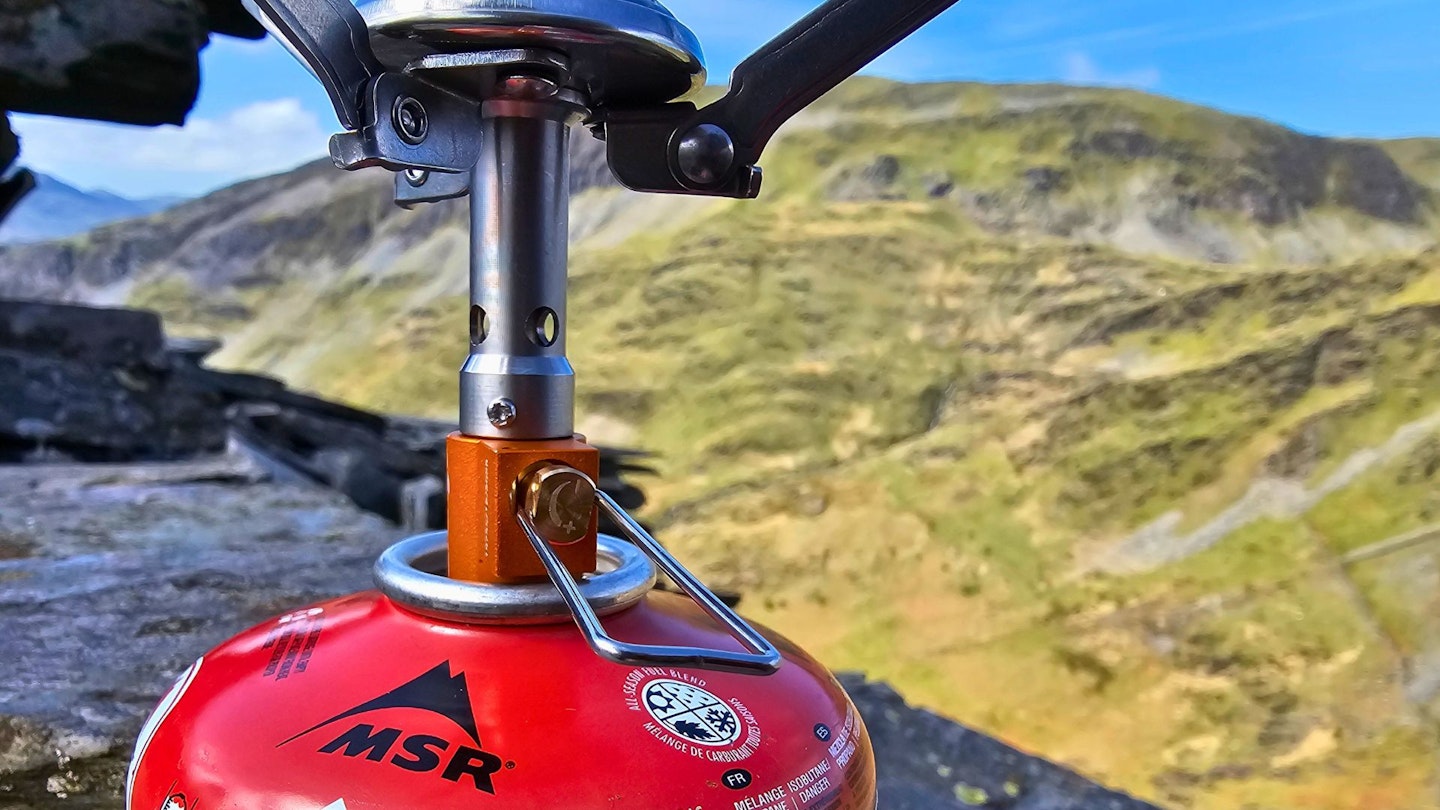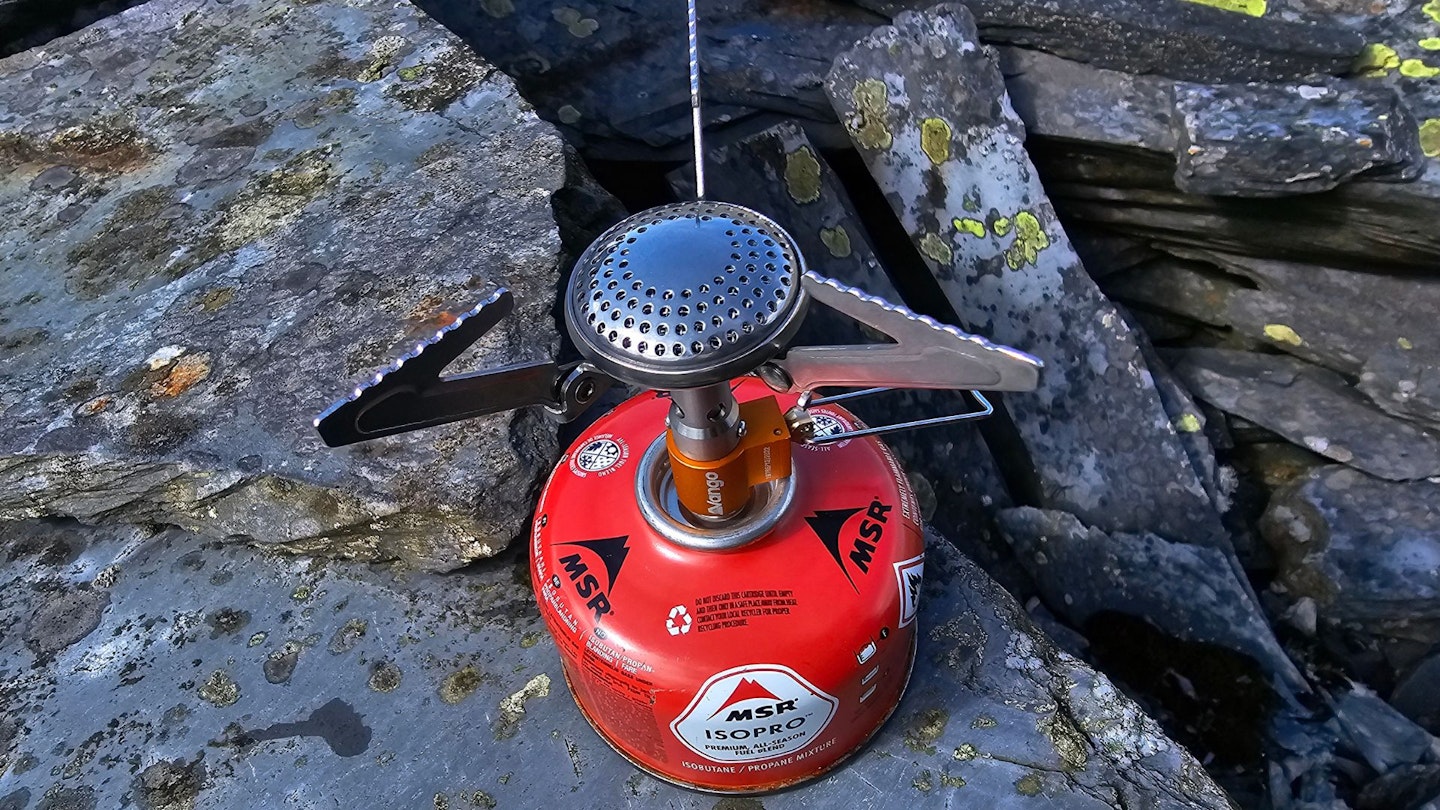Originally established in Scotland in 1966, Vango is one of the oldest and best-loved British outdoor brands. It has plenty of heritage when it comes to adventures in the great outdoors and all sorts of outdoor kit, including backpacking stoves.
Today, Vango kit is still popular with hillwalkers and campers, including youth groups like the Scouts and Duke of Edinburgh’s Award scheme. There’s also a higher-end range of technical tents in the F10 range that continue to push the boundaries of shelter design.
When it comes to camp stoves and cookware, Vango makes a range of products suitable for everything from backpacking through to larger camping stoves for family camping or campervanning. The ultralight Vango Atom stove is very much geared towards ‘fast and light’ users, whilst still being very affordable.
 LFTO
LFTOPros
- Affordable
- Powerful
- Very light and compact
Cons
- Poor simmer control
- Lacks in-built ignition
- Susceptible to wind
| Weight | 65g (70g packed in storage bag) |
| Packed size | 6.5 x 4cm |
| Boil time | 4 minutes 2 seconds (0.5L of water at ambient 17°C) |
| Power output | 3,000W (10,236 BTU/hr) |
Design

The design of the Vango Atom prioritises low weight and a small pack size over anything else. As a result, it weighs just 65g and packs away into a very compact little stuff sack – or you could simply nest it inside a cooking pot or mug. That makes it a good option for lightweight backpackers who want to build a small solo cookset.
It’s very much a no-frills stove, since it lacks a regulator for consistent power output and has no built-in ignition. On the other hand, it has sturdier pot supports, a broader burner head and a larger, more user-friendly wire control lever than a lot of ultralight micro stoves. It’s still inferior in these regards to premium rivals like the JetBoil MightyMo, SOTO Windmaster and MSR Pocket Rocket Deluxe, but then again, it’s a lighter and more compact design than any of those stoves, as well as being significantly cheaper.
Build quality and overall finish is good, with anodised aluminium components and a brushed finish to the burner stem. This doesn’t feel like a cheap, disposable bit of kit, despite the low price point.
Performance

With a rated power output of 2,900W, the Vango Atom has plenty of grunt. It’s more powerful than most other micro backpacking stoves in its weight and price bracket. In our boil test, it boiled half a litre of water in a fraction over four minutes – and that was in real world conditions, with a 6mph breeze. Not too shabby. If you can keep the stove sheltered from wind, you’ll likely get faster results than that.
The convex burner head measures about 4cm in diameter, which again is wider than most micro stoves. This makes for more even heat distribution and fewer hotspots, though it’s still a stove better suited to boiling water than more complex cooking tasks.

The design of the triple pot supports puts the base of your cooking pot fairly close to the burner head, which is a plus for stability and heat transfer, but it can scorch the middle of your pot if you’re not attentive. We also found that this stove is vulnerable to wind. It’s easy to blow it out, especially at low power. Again, if you’re wild camping in the hills with the Atom, we’d recommend trying to find a natural windbreak (like a drystone wall, sheepfold or rocky outcrop) and/or carrying a windshield.
Weight and packed size

When folded away, the Vango Atom nestles in the palm of a hand. It’s a very lightweight and compact bit of kit, tipping the scales at just 65g and measuring a mere 6.5 x 4cm.
Those are pretty impressive specs, though of course there are a few ultralight micro stoves that are lighter still – like the 45g Alpkit Kraku, Robens Fire Midge and Fire Maple FMS-300T (which are all essentially the same stove, just made under license for different brands). Then there’s the 25g BRS-3000T, which is much loved by budget lightweight backpackers. All of those have tiny burner heads and small pot supports though, which aren’t as stable or effective as the Atom’s slightly larger but more practical design.
Ease of use

The Atom is relatively quick and easy to set up, especially once you’ve done it a couple of times – the triple pot supports need to be unfolded and then rotated into place, but it’s all fairly intuitive. Then you just screw it onto your gas canister, flick out the wire control lever and fire it up.
It lacks an in-built piezo ignition, so you will need to remember to pack matches, a lighter or a firesteel – but then, most backpackers would be taking at least one of these (if only as a back-up) even if their stove does have an integrated ignition.
In use, the stove will comfortably support a pot or pan up to 12cm in diameter. Anything bigger than that overhangs the triple support arms, which means things start to get a bit unwieldy, especially if you’re using a larger 230g or 450g gas canister. We’d recommend investing in a folding canister stand, since these are light and compact as well as being inexpensive but make a big difference to overall stability.

The stove does have (limited) simmer control – it takes about one and a half full turns to go from minimum to maximum power, so it isn’t quite ‘all or nothing’ – but the Atom lacks the precision of more expensive rivals like the Jetboil MightyMo, SOTO Windmaster and MSR Pocket Rocket
Deluxe. Essentially, it’s better suited to brewing up fast than more delicate cooking tasks. Don’t expect to be able to do too much gentle simmering with the Atom, especially if you’re out in breezy conditions.
Lastly, if you’re blazing away at full power, you also need to watch you don’t burn yourself when using the control lever. The wire bail that is used to adjust the flame is bigger than that found on rival micro stoves, but it still puts your fingers close enough to the burner head to require a fair bit of care and attention.
Price and competition

The Vango Atom definitely sits at the affordable end of the backpacking stoves market. The current UK RRP is £32.60, though a good target price is £20 to £25. It’s great value if you just want a simple but reliable no-frills stove for brewing up and boiling water for dehydrated or freeze-dried pouch meals.
As such, we’d recommend it over most other rivals in this price bracket, even though there are a few options that are even lighter and more compact than the Atom. The problem with those is that they are so tiny they tend to be inherently unstable, so it’s super easy to accidentally knock your pot or mug off the burner in use. The Atom doesn’t have the widest pot supports, but they’re still a bit more stable than those rivals. Similarly, the Atom’s burner head is larger in diameter too, which makes for better heat distribution. And it’s more powerful in terms of Kw output, which should give you quicker boil times.
Verdict
Compact, very lightweight and affordable, yet still packing plenty of power, the Atom is a great value choice for weight-conscious backpackers on a budget.
How we tested the Vango Atom

This stove was tested by Matt Jones, the former editor of Walk magazine and Scouting magazine. Matt is one of the most respected names in the UK outdoor industry and now works as a freelancer out of Snowdonia. He put the stove to the test over Spring 2024.
The boil test was conducted in real world conditions on a warm spring day in Snowdonia, measuring the time taken to boil 500ml of water at sea level in a 6mph wind, ambient temp 17°c, starting water temp 17.1°c. An 800ml hard anodised aluminium pot with a lid was used, with a standard 450g butane/propane mix gas canister as fuel.
